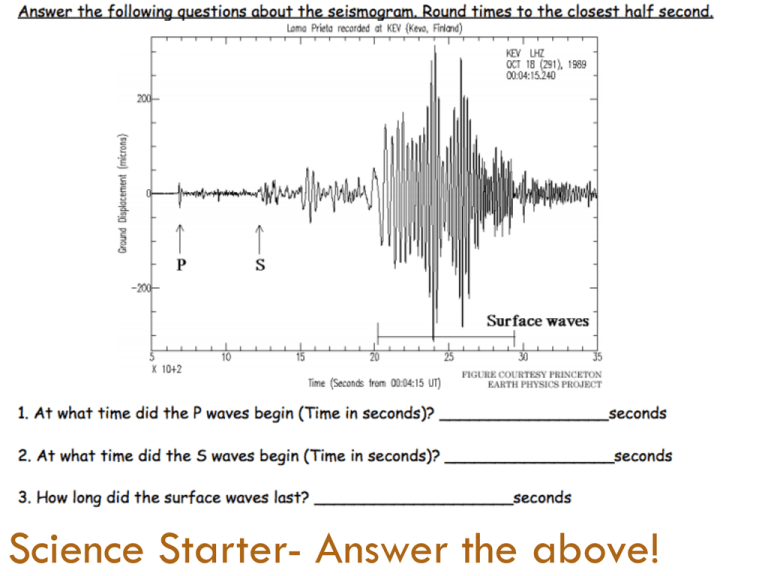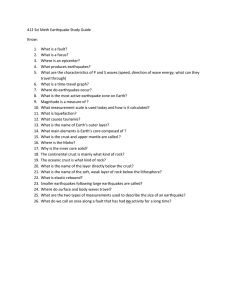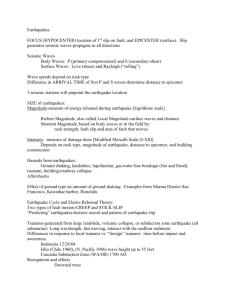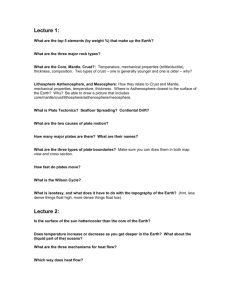Science Starter
advertisement

Science Starter- Answer the above! WHAT IS AN EARTHQUAKE AND HOW DO WE MEASURE THEM? Chapter 8, Section 8.1 & 8.2 Looking Back What is an Earthquake How is it measured Seismograms/Seismograph Faults and Fault Types Richter Scale and Moment magnitude Let’s Review List the three different seismic waves: Surface What is a fault? A fracture in Earth where movement has occurred. What is the source of an earthquake called? The Waves, P Waves, and S Waves focus What order to the three basic types of seismic waves reach a seismograph in? P Waves, S Waves, Surface Waves Looking Ahead Tomorrow we are going to start Chapter 9 (Plate Tectonics) Vocabulary Quiz Chapter 8 on October 31st!! Test Chapter 7 – 9 on November 4th! Today’s Plan Finish Sections 8.2 & 8.3 Bill Nye episode on Earthquakes Destruction from Earthquakes The Good Friday Alaskan Earthquake in 1964 was one of the most violent earthquakes to jar North America in the 20th century Moment Magnitude of 9.2 Lasted 3-4 minutes Killed 131 people Thousands homeless Affected major ports and towns Luckily the schools and businesses were closed so the damages were not higher! Good Friday Quake Damage Good Friday Quake Damage Seismic Vibrations The 1964 Alaskan Earthquake gave geologists new insights into the role of ground shaking as a destructive force. The damage to buildings and other structures from earthquake waves depends on several factors: Intensity of vibrations Duration of vibrations Nature of material on which the structure is built Design of the structure Building Design All multistory buildings in Anchorage, Alaska, were damaged by the vibrations of the earthquake. However the more flexible wood buildings like homes were less damaged. Steel also withstands vibrations. Engineers have learned that unreinforced stone or brick buildings are the most serious safety threats during earthquakes! Why do you think that is? Building Design Brick Steel Liquefaction Loosely consolidated sediments are saturated with water. When an earthquake shakes these sediments a process called liquefaction can occur. Stable soil turns into a liquid that is not able to support buildings or other structures. May settle and collapse Underground storage tanks may float toward the surface. Liquefaction in action http://www.youtube.com/watch?v=u8hfCN6k3YE Liquefaction in Action http://www.youtube.com/watch?v=j0sLyJpfTE8 Tsunamis Most death’s associated with the 1964 Earthquake were caused by seismic sea waves (tsunamis). Indonesia 2004 Japan 2011 Tsunami means “harbor wave” Often called tidal waves Incorrect because these waves are not caused by tides. Causes of Tsunamis A tsunami triggered by an earthquake occurs where a slab of the ocean floor is displaced vertically along the fault. Can also occur when the vibration of a quake sets an underwater landslide in motion. Other causes (no common): From land landslides Meteor Strikes Causes of Tsunamis Once formed, a tsunami resembles ripples (like when you throw a pebble into a pond). Tsunami travels across the ocean at speeds of 500 to 960 kilometers per hour (310-600mph) Tsunamis in the ocean often pass without notice because they are usually less than 1 m high and the distance between wave crests is anywhere from 100 to 700 km apart. As wave enters shallow coastal water, the waves slow down and water PILES UP to heights that sometimes are higher than 30m (100ft). Tsunami Formation Tsunami Crests in the Ocean (Japan 2011) http://www.youtube.com/watch?v=rUED6HeGJ7w Tsunami Damage (Japan 2011) http://www.youtube.com/watch?v=J2hUwFo6Vpc Tsunami Comparison Please write down some observations you notice about the BEFORE DAMAGE and AFTER DAMAGE of the Tsunami in Japan 2011. Here Tsunami Warning System The destruction from a large tsunami in the Hawaiian Islands led to the creation of a tsunami warning system for the coastal areas of the Pacific. Large earthquakes are reported to the Tsunami Warning Center in Honolulu from seismic stations around the Pacific. Scientists use water levels in tidal gauges to determine whether or not a tsunami has formed. Within an hour of the reports, a warning is issued. Usually enough time to evacuate all but the area closest to the epicenter. Sometimes the epicenter is too close to land to do much. Only one or two destructive tsunamis are generated worldwide each year. Only 1 tsunami every 10 years causes major damage and loss of life. Other Dangers of Earthquakes Vibrations from earthquakes cause other dangers! Landslides: With many earthquakes, the greatest damage to structures is from landslides and ground subsidence (or the sinking of the ground) due to vibrations. Violent shaking causes rocks and soil to fall on slopes Can cause large sections of ground to collapse, liquefy, or subside. Can cause foundations to collapse Rupture gas and water pipelines Landslides in China Fire The 1906 San Francisco earthquake reminds us of the major threat of fire. City contained mostly wooden structures and brick buildings. Greatest destruction was caused by fires that started when gas and electrical lines were cut. Water lines also broken by earthquake. Fire couldn’t be stopped Predicting Earthquakes Short Range Prediction: Goal of short-term predictions is to provide an early warning of the location and magnitude of a large earthquake. Researchers monitor possible precursors (things that precede and may warn of a future earthquake). Uplift of land Subsidence of land Strain in rocks near active faults Water levels and pressures in wells Radon gas emissions from fractures Small changes in electromagnetic properties of rocks But so far, short-range predictions of earthquakes have not been successful! Predicting Earthquakes Long Range Forecasts: Give the probability of a certain magnitude earthquake occurring within 30-100+ years. Based on the idea that earthquakes are repetitive or cyclical. Important for updating building codes. As soon as one is over, forces start building up again. Scientists study historical records of earthquakes to see if there are any patterns of recurrence. Study seismic gaps: an area along a fault where there has not been any earthquake activity for a long period of time. Only LIMITED success in predicting earthquakes with longterm forecasts. Scientists do not yet understand enough about HOW and WHERE earthquakes will occur to make accurate longterm predictions. INTERNAL STRUCTURE OF EARTH Earth’s Interior Interior of Earth does not lie very far beneath our feet but we cannot reach it. Deepest well has only been drilled 12km into Earth’s crust. So how do we know what the inside of Earth looks like? Most knowledge of the interior comes from the study of earthquake waves that travel through Earth! Layers defined by Composition If Earth were made out of the same materials throughout, seismic waves would spread through it in a straight line at a constant speed. This is not the case! Seismic waves reaching seismographs located father from an earthquake travel at faster average speeds than those recorded at locations closer to the epicenter. General increase in speed with depth is due to increased pressure, which changes elastic properties of deeply buried rock. The paths of seismic waves are refracted, or bent, as they travel. This is because of earth’s interior! Layers defined by Composition Earth’s interior consists of three major zones defined by its chemical composition: Crust Mantle Core Layers defined by Composition - CRUST The crust, the thin, rocky outer layer of Earth, is divided into: Oceanic Crust 7km thick, made of the igneous rocks basalt and gabbro. Younger (180 million years or less) Density of 3.0g/cm3 Continental 8-75km Crust thick, average thickness is 40km Made of many rock types, but mostly granodiorite. Density of 2.7g/cm3 Some parts are over 4 BILLION years old! Layers defined by Composition - Mantle Over 82% of Earth’s volume is contained in the mantle. Solid, rocky shell that extends to a depth of 2890 km. Boundary between crust and mantle represents a change in chemical composition. Dominant rock in upper: peridotite (3.4g/cm3) Layers defined by Composition - Core Sphere composed of an iron-nickel alloy. Extreme pressures so the density is almost 13g/cm3 13 times heavier than water. Layers defined by Physical Properties Earth’s interior has a gradual increase in temperature, pressure, and density with depth. When a substance is heated, its chemical bonds weaken and its mechanical strength is reduced. If temperature exceeds melting point, the material’s bonds break and melting begins. But temperature is not the only thing that determines if something melts! Pressure also increases with depth and increases rock strength. Depending on the physical environment (temp and pressure) a material can act like a brittle solid, a putty, or a liquid. Earth can be divided into layers based on physical properties: Lithosphere, Asthenosphere, Outer Core, and Inner Core Layers defined by Physical Properties – Lithosphere and Asthenosphere Earth’s outermost layer consists of the crust and the UPPERMOST mantle and forms a relatively cool, rigid shell called the lithosphere. Averages about 100km in thickness. Beneath the lithosphere is a soft, weaker layer known as the asthenosphere. Temperatures/pressure conditions that result in a small amount of melting, but not a lot. Close enough to melting temperatures that they deform easily. (Ex: hot wav is weaker than cold wax) Lithosphere and Asthenosphere both part of upper mantle. Asthenosphere and Lithosphere Layers defined by Physical Properties – Lower Mantle From a depth of about 660km down to near the base of the mantle lies a more rigid layer called the lower mantle. Despite their strength, rocks of lower mantle are very hot and still capable of gradual flow. The bottom few hundred km of mantle (laying on top of hot core) contains softer, more flowing rock like that of the asthenosphere. Layers defined by Physical Properties – Inner and Outer Core The core is composed mostly of an iron-nickel alloy is divided into two regions with different physical properties. Outer core: Liquid layer 2260km thick Flow of metallic iron in this layer generate Earth’s magnetic field! Without the magnetic field, our atmosphere would burn off! Inner Core: Sphere having radius of 1220 km. High temperature, but pressure is so high that the material is compressed into a solid state. Discovering Earth’s Layers 1909 – Croatian seismologist (Andija Mohovoricic) presented evidence for layering within the Earth. Studied seismic records and found that the velocity of seismic waves increases abruptly below about 50km of depth. This boundary separates the crust from the mantle and is called the Mohorovicic discontinuity (Moho for short). Another boundary was found between the mantle and outer core. Seismic waves from even small Earthquakes can travel around the world. Observed that p-waves were bent around the liquid outer core beyond about 100 degrees away from an earthquake. Outer core also causes p waves that ravel through the core to arrive several minutes later than expected. This region where bent P waves arrive bent is called the shadow zone. Layers of Earth and Seismic Waves Discovering Earth’s Layers The bent wave paths can be explained if the core is composed of material that is different from the overlying mantle. P waves bend around the core in a way similar to waves being bent around the corner of a building. Outer core does not stop P waves in the shadow zone, but bends them. S waves CANNOT travel through the outer core so geologists concluded that this area is liquid. Layers of Earth and Seismic Waves Discovering Earth’s Composition Early seismic data and drilling technology indicate that the continental crust is mostly made of lighter granitic rocks. Until the late 1960s, scientists had only seismic evidence they could use to determine the composition of oceanic crust. Recovery of ocean-floor samples was made possible with the development of deep-sea drilling technology The crust of the ocean floor has a basaltic composition Discovering Earth’s Composition Composition of rocks of the mantle and core is known from more indirect data: Lava that reaches earth’s surface comes from partially melted asthenosphere within the mantle sometimes. Meteorites that hit earth provide with hints about Earth’s composition. Assumed to be made of the same material from which Earth was formed. Composition ranges fom metallic meteorites made of iron and nickel to stony meteorites composed of dense rock similar to peridotite. Discovering Earth’s Composition Earth’s crust contains a smaller amount of iron than do meteorites so geologists believe that the dense iron and other dense metals sank toward Earth’s center during the planet’s formation. Lighter substances may have floated to the surface to create the less-dense crust. Earth’s core is thought to be mainly dense iron and nickel, similar to metallic meteorites. Surrounding mantle is thought to be composed of rocks similar to stony meteorites. Let’s Review What is the composition of Earth’s Core? Iron and Nickel Alloy What is the composition of Earth’s mantle? Peridotite What destructive events can be triggered by an earthquake? Landslides, tsunamis, and fires What is a seismic gap? An area along a fault that has not had any earthquake activity for a long period of time.









